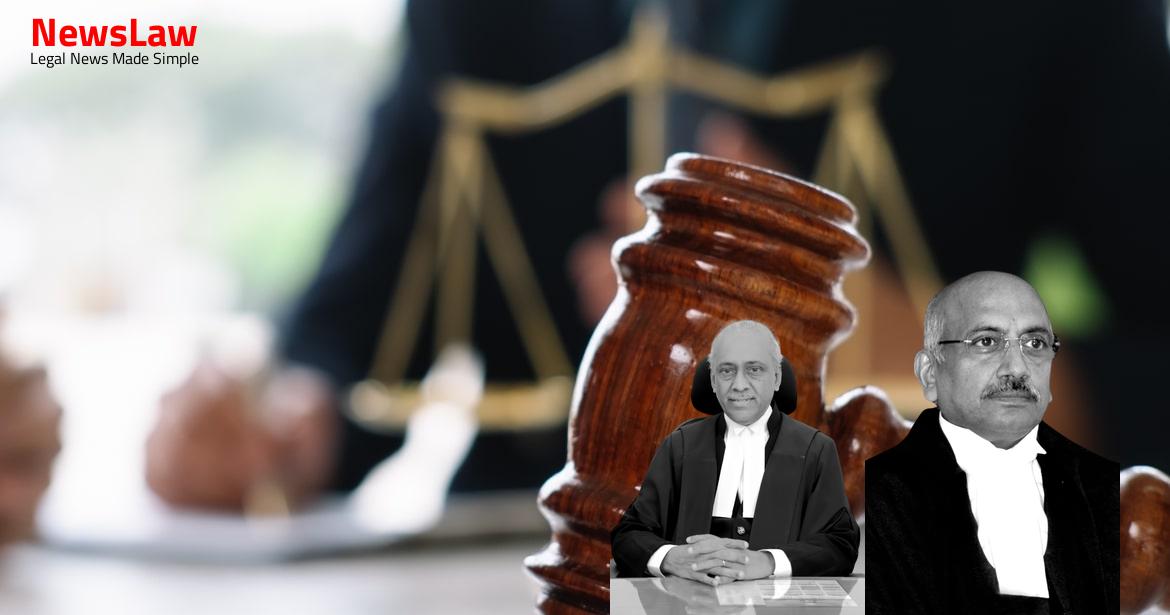The Madras High Court delves into a comprehensive legal analysis of the forfeiture of properties under the 1976 Act. Through a detailed interpretation of Sections 6, 7, and 9, the court elucidates the procedural intricacies and the burden of proof essential for property forfeiture proceedings. This blog focuses on the court’s meticulous scrutiny of the statutory provisions governing property forfeiture, emphasizing the importance of due process and substantiating links between illegally acquired assets and the convict or detenu.
Facts
- Respondents filed Writ Petitions in the Madras High Court challenging the forfeiture of properties.
- Appellants appealed to the court against the High Court’s decision.
- The order of forfeiture issued by the Competent Authority was upheld by the court.
- The matter was brought before the court through Writ Petitions.
- Both writ petitions allowed by a common judgment on 24.3.2008 by the Division Bench of the Madras High Court.
- Action against the respondents deemed vitiated due to lack of notice to V.P. Selvarajan, as required under Section 6 of the 1976 Act.
Also Read: Land Acquisition Act Interpretation Case
Arguments
- The respondents were holding the subject properties on behalf of the convict who was convicted under the 1962 Act.
- The conundrum in the appeals is whether a primary notice under Section 6(1) of the 1976 Act should be served upon the convict when the Competent Authority claims that the subject property is that of the convict and held by the relatives of the convict (respondents herein).
- The Madras High Court concluded that a primary notice to the convict was a mandatory requirement in such a fact situation, as per Section 6 of the 1976 Act.
- The respondents argue that the appellants proceeded against them assuming they are ostensible owners and the properties actually belonged to the convict, but the Competent Authority failed to provide proper reasons to believe as required by Section 6 of the 1976 Act.
- It is further contended that the proceedings suffer from arbitrariness and irrationality due to inordinate delay, citing rulings in Nazir Ahmad vs Emperor and Chandra Kishore Jha vs. Mahavir Prasad & Ors.
- The argument emphasizes that when a statute specifies a certain procedure, it should be followed exclusively in that manner.
- Reliance has been placed on the dictum in Amratlal Prajivandas to decode the intent of the legislation and relevant provisions.
- The Act applies to the respondents as the spouse and son of the convict’s brother fall under the definition of ‘relative’ in the 1976 Act.
- The term ‘held’ in Section 6 of the 1976 Act includes those entitled to possession of property and those in possession as per the definition in The Major Law Lexicon.
- The burden of proof lies on the relative or associate of the convict to establish that the properties mentioned in Section 6 notice were not illegally acquired.
- The Act aims to prevent the screening of illegally acquired properties regardless of how they are held by relatives/associates.
- Reference to the case Shobha Suresh Jumani vs Appellate Tribunal, Forfeited Property & Anr. where forfeiture action was upheld against the detenu’s wife for holding properties.
- The respondents argue that a nexus between the properties sought to be forfeited and the convict or detenu must be alleged and established by the Department when issuing a notice to a relative as per Section 6(1).
Also Read: Authority of CMM/DM to Appoint Advocate in Secured Asset Cases
Analysis
- The Competent Authority is required to issue notice under Section 6 of the Act to any person to whom the Act applies, including the convict, his relatives, and associates.
- The notice under Section 6 initiates forfeiture action or fine in lieu of forfeiture as per Sections 7 and 9 of the Act.
- The purpose of issuing notice is to allow the noticee to discharge the burden of proof, as specified in Section 8 of the Act.
- The Act aims to reach illegally acquired properties of the convict or detenu held by relatives or associates, regardless of the acquisition time.
- The Act does not intend to forfeit properties of relatives or associates unless a link or connection with the convict/detenu’s illegal activities is established.
- If the illegally acquired property is held by a person in legal possession, notice need not be issued to the convict but to the person in possession, such as relatives.
- The burden of proof under Section 8 shifts to the person holding the property, not to the convict or detenu.
- The legislative intent is to ensure that properties held by relatives or associates of the convict are not shielded from forfeiture.
- Forfeited properties must be traceable to the illegal sources of income, earnings, or assets of the convict or detenu.
- Personal properties of relatives or associates of the convict or detenu without a connection to the convict or detenu cannot be forfeited under the 1976 Act.
- Properties subject to forfeiture must substantiate a link or nexus with the convict’s activity, especially for non-immediate relatives.
- Legislation requires a rational connection for reasons to believe and satisfies conditions under Section 6 of the Act.
- Recording reasons to believe is a jurisdictional requirement, violation has legal consequences.
- The Act applies not only to the detenu but also to their relatives and associates.
- Initiating action against a relative is independent of any action against the detenu under SAFEMA.
- Proceedings against relatives can be initiated even if the detenu is not proceeded against under SAFEMA.
- Violation of foreign exchange and tax laws impacts proceedings if not complied with.
- Primary notice under Section 6 must be served on the convict to indicate sources of income for forfeited properties.
- Convict not expected to offer explanation for property held by relatives on his behalf.
- Properties must rightfully belong back to the State as per the Act.
- The purpose of the Act is to counteract devices adopted by certain persons and their relatives or associates.
- The Act aims to forfeit the properties of convicts/detenus and reach properties held by their relatives or associates.
- The Competent Authority initiates the process by issuing a notice under Section 6 of the Act to the person holding the properties proposed to be forfeited.
- Section 6(1) specifies that the noticee may hold the property either by himself or through any other person on his behalf.
- Notices under Section 6(1) can be issued only to persons specified in Section 2(2) of the Act.
- The Act applies to relatives or associates holding illegally acquired property of convicts or detenus.
- The Act also encompasses holders of property previously held by convicts or detenus.
- The expression ‘relatives’ and ‘associates’ are elaborated in Explanation 2 of Section 2 of the Act.
- The Act does not include the properties of relatives or associates acquired illegally under its purview.
- Sections 18 and 8 of the Act are crucial in the procedural steps before issuing forfeiture notices.
- Section 7 deals with the forfeiture of property in certain cases after considering explanations and hearing concerned parties.
- The Act prohibits persons to whom it applies from holding illegally acquired property either by themselves or through others.
- Explanation 1 and 2 of Section 2 provide clarity on the valuation of goods and definitions of ‘relatives’.
- Explanation 3 defines ‘associates’ in the context of the Act.
- Acts of commission and omission under the Act imply prohibition and make such actions void.
- Section 4 of the Act explicitly prohibits holding illegally acquired property and outlines forfeiture provisions.
- Convict V. P. Selvarajan had expired before the issuance of notice under Section 6, so serving him notice is unnecessary.
- Different considerations would apply if the properties were in the name of the deceased detenu or convict.
- The heirs of the deceased convict V. P. Selvarajan have not claimed any entitlement or right in these properties.
Also Read: Analysis of Compensation Method in Land Acquisition Case
Decision
- The appeals have succeeded and pending applications have been disposed of.
- The common impugned judgment dated 24.3.2008 by the Madras High Court has been set aside, leaving all other contentions open.
- The writ petitions are restored to the file for reconsideration on their merits in accordance with the law.
- All issues and contentions are open for reconsideration except those answered in this judgment.
- Respondents appealed to the Appellate Tribunal for Forfeited Property in Bangalore, which dismissed the appeals on 15.11.2000.
- The High Court has been requested to promptly handle the remanded writ petitions.
Case Title: INCOME TAX OFFICER AND ANR. Vs. V.MOHAN AND ANR. (2021 INSC 886)
Case Number: C.A. No.-008592-008593 / 2010



